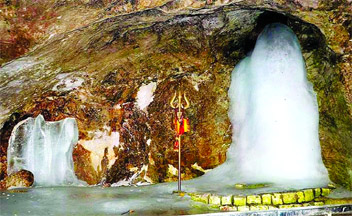
Amarnath Yatra is among the most revered pilgrimage circuits among Hindus. This annual event starts in July and goes on till mid-August every year. This holy Yatra lasts for around 45 days and is undertaken by thousands of people from all over the country.
This year, the Amarnath Yatra starts from June 29 and will end on August 19.
Nestled in the lap of the mighty Himalayas in the Anantnag District of Kashmir, Amarnath Cave is one of the most celebrated Hindu shrines that hold spiritual significance among the devotees.
Situated at an altitude of 3,888 m above sea level, Amarnath Cave houses an ice stalagmite that symbolizes the mythical power of Lord Shiva. This ice Shiva Lingam is the prime attraction of the Amarnath Cave, which shrinks and grows with the phases of the moon.
This prominent Hindu shrine is dedicated to Lord Shiva, which has many lore and legends related to pilgrimage and Amarnath Yatra.
Here is the religious significance of Amarnath Yatra along with the significance and history of the shrine and Yatra.
Amarnath History: Who discovered the Amarnath Cave?
According to the local folklore, the Amarnath Cave was discovered by a Muslim shepherd Buta Malik in 1850. According to the lore, he was roaming with his herds in the mountains, and a saint met him there.
The saint gave him a bag full of coal, and when he reached home, he opened the bag, and he found a bag full of gold instead of coal. He was overjoyed and ran back to the same place to thank the saint, but he did not find the saint. Instead, he found the cave and the ice Lingam.
He informed the villagers about this and shared this story, after which the pilgrimage to Amarnath Cave started.
According to myths, the Kashmir Valley was submerged underwater, and Sage Kashyap drained it through a series of rivers and creeks. After this incident, Rishi Bhrigu was the first to have discovered Amarnath.
He has had a darshan of Lord Shiva at Amarnath, and after listening to this story, people started to undertake the pilgrimage circuit to Amarnath Cave.
Legends and Mythology of Amarnath Cave
There are numerous legends related to the Amarnath Cave. Among them, there is a most famous legend, which depicts that Lord Shiva has chosen this place to share the secret of immortality and the process of formation of the universe with Goddess Parvati.
He shared the story with Goddess Parvati about why he wears a bead of heads and what it implies. He told her that the head in the bead increases every time she is reborn. To this, Goddess Parvati asked about the reason behind Lord Shiva’s immortality.
He told her that she demanded to hear Amar Katha, which is a difficult task to listen for a human in one go and without sleeping.
She keeps insisting on Lord Shiva narrating the story, and then after a long time, he agrees to tell her the story at this place. For this, he was looking for a lonely place where no one could hear the story except for Mata Parvati.
On the way to Amarnath Cave, he left all these belongings en route, including his snake at Sheshnag Lake, Nandi bull at Pahalgam, his moon at Chandanwari, his son at Mahagunas Parvat, and at Panjtarni he left his five elements (Earth, Fire, Water, Air, and Sky).
Lord Shiva entered the holy cave with Goddess Parvati, sat on the deerskin, and took a Samadhi. To ensure that there was no one in the cave, he created a Rudra named Kalagni and ordered him to set the cave ablaze so that everything living there will be destroyed.
He then started narrating the story of immortality to the Goddess Parvati. But, Lord Shiva was unaware that there was an egg that remained protected under the deerskin on which the Lord was sitting.
A pair of pigeons were born out of that egg and allegedly became immortal after listening to the story while in the egg form.
Today, after all these years, the pilgrims can see the pair of pigeons while going towards the Amarnath Cave. They are fondly referred to as ‘Amarnath Pigeon,’ and it is believed that they are the same pigeons who have listened to the story of immortality.
Significance of Amarnath Temple
The most prominent feature of Amarnath Cave Temple is the Shiva Lingam, which is 40 m inside the cave. It is formed due to the dripping of freezing water from the cave’s ceiling and grows vertically on the cave floor to form the Lingam.
As per scientific terms, it is a stalagmite. As per Hindu mythology, the Lingam comprises the mythical energy of Lord Shiva. It is believed that the Shiva Lingam grows and shrinks as per the phase of the Moon, although there is no scientific proof for the same. Apart from the main Linga, two other ice formations can be seen in the cave, which is believed to be Goddess Parvati and Lord Ganesha.
Now, you have gained knowledge about the religious and mythological significance of Amarnath Yatra. As Amarnath Cave is where Lord Shiva narrates the Amar Katha or story of immortality to Goddess Parvati, it is one of the holiest pilgrimage sites for devotees.
Plan your pilgrimage to Amarnath cave and witness the spiritual charm of Baba Barfaani. This serene place’s breathtaking landscape and mystical vibes can leave anyone captivated and awe-struck.
Due to heavy snowfall and extremely bad weather throughout the year, devotees can access the cave only for 2 months, which are July and August. According to the Hindu calendar, the month of Shravan is when the cave becomes accessible, and the Ice Shivling is at its fullest. This trek, which has two routes, one via Pahalgam (45 km long route) and the second via Baltal (14 km shorter but steep route), witnesses devotees from 13 to 70 years of age walking with the same zeal and enthusiasm. Both routes will take you through beautiful snow-capped mountains and breathtaking views and will challenge you physically and mentally as well.





Be the first to comment